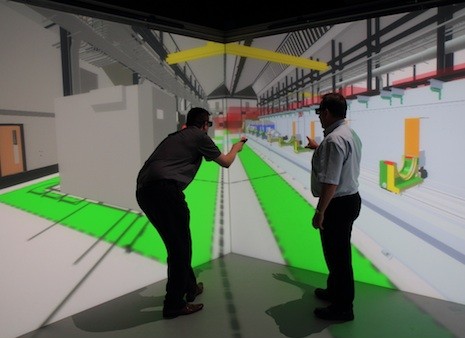Difference between revisions of "Project3S17"
(→Starter Code) |
(→Project Description (100 Points)) |
||
| Line 20: | Line 20: | ||
In this project you are tasked with creating a simulator for a 3-sided VR CAVE. This means that you need to create a virtual CAVE, which you can view with the Oculus Rift. In this CAVE you will need to display a sky box and the calibration cube from project 2. You will need to be able to switch between the view from the user's head and a view from one of the Oculus controllers. | In this project you are tasked with creating a simulator for a 3-sided VR CAVE. This means that you need to create a virtual CAVE, which you can view with the Oculus Rift. In this CAVE you will need to display a sky box and the calibration cube from project 2. You will need to be able to switch between the view from the user's head and a view from one of the Oculus controllers. | ||
| + | |||
| + | The virtual CAVE should consist of three display screens. Each screen should be square with a width of 2.4 meters (roughly 8 feet). One of the screens should be on the floor, the other two should be vertical and seamlessly attached to the screen on the floor and to each other at right angles, just like in the picture. This application should be used standing, with the viewpoint set to your height so that it appears as if you're standing on the floor screen. | ||
Revision as of 09:40, 7 May 2017
CAVE Simulator
This project is currently under construction, until we post a note on Piazza that it is complete. Regardless, you are welcome to start writing code for it. We may still change details about the project but the general idea won't change.
In this project you will need to create a VR application for the Oculus Rift, which simulates a virtual reality CAVE. Like in projects 1 and 2, you're going to need to use the Oculus SDK, OpenGL and C++.
Starter Code
You can start with your code from project 1 or 2, or go back to the Minimal Example. We will re-use the calibration cube and the sky box from project 2 so at least those parts of that project will be useful to you.
This link provides a great explanation (including source code) of how to create an off-center projection matrix as you will need it in this project.
Project Description (100 Points)
This picture shows what a 3-sided virtual reality CAVE can look like:
Looking closely at the image, you will find that the yellow cross bar at the top does not look straight in the image, although it does to the primary user. In the image it is bent right where the edge between the two vertical screens is. This is typical behavior of VR CAVE systems, as they normally render the images for one head-tracked viewer. All other viewers see a usable image, but it can be distorted.
In this project you are tasked with creating a simulator for a 3-sided VR CAVE. This means that you need to create a virtual CAVE, which you can view with the Oculus Rift. In this CAVE you will need to display a sky box and the calibration cube from project 2. You will need to be able to switch between the view from the user's head and a view from one of the Oculus controllers.
The virtual CAVE should consist of three display screens. Each screen should be square with a width of 2.4 meters (roughly 8 feet). One of the screens should be on the floor, the other two should be vertical and seamlessly attached to the screen on the floor and to each other at right angles, just like in the picture. This application should be used standing, with the viewpoint set to your height so that it appears as if you're standing on the floor screen.
